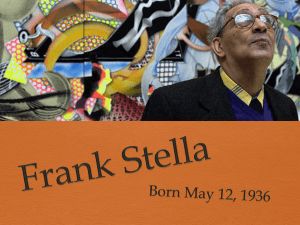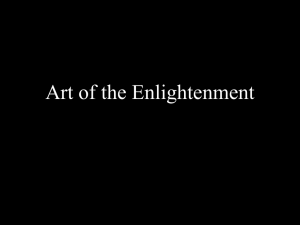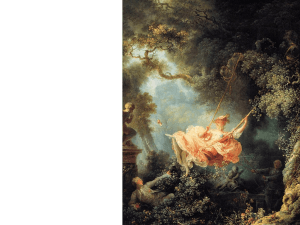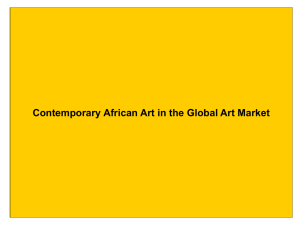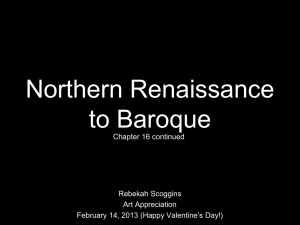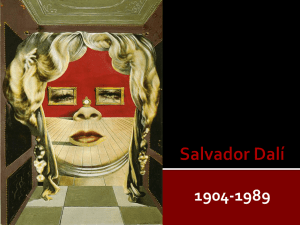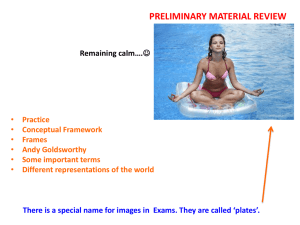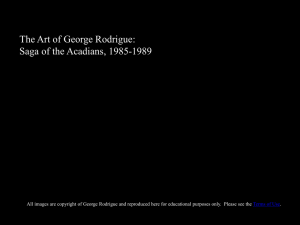STILL LIFE, PEOPLE, LANDSCAPE, ABSTRACT
advertisement
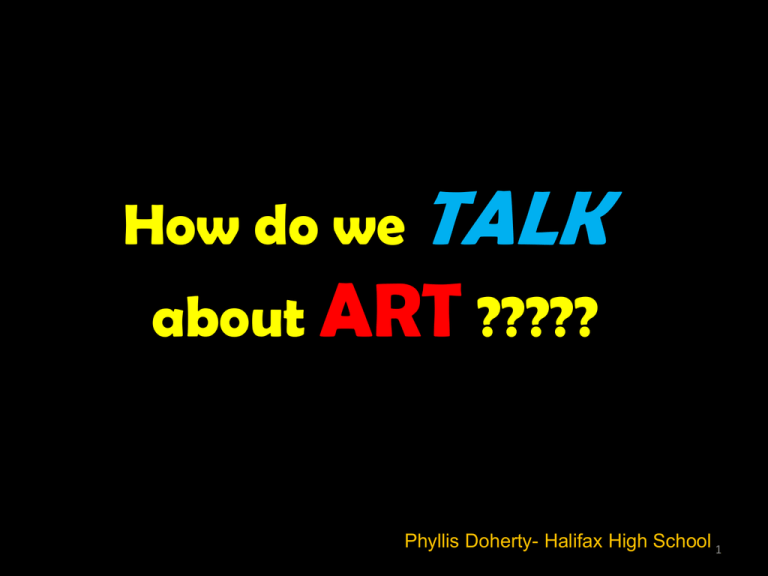
How do we TALK about ART ????? Phyllis Doherty- Halifax High School 1 Discuss the SUBJECT People, Still Life, Landscape, Abstract 2 DISCUSS the STYLE Abstract Expressionism Contemporary Realism Cubism Expressionism Futurism Impressionism Op Art POP art Realism Surrealism 3 ABSTRACT EXPRESSIONISM • • “Abstract Expressionism is a type of art in which the artist expresses himself purely through the use of form and color. It is non-representational, or non-objective, art, which means that there are no actual objects represented.” Jackson Pollock (American, 1912–1956) War, 1947 Pen and ink, and colored pencils on paper; 20 5/8 x 26 in. 4 ACTION PAINTING or “drip” painting • Jackson Pollock (artist) American, 1912 – 1956 Number 1, 1950 (Lavender Mist), 1950 oil, enamel and aluminum on canvas Overall: 221 x 299.7 cm (87 x 118 in.) National 5 Gallery of Art COLOR FIELD PAINTING Mark Rothko (painter) American, born Russia, 1903 - 1970 Untitled, 1949 oil on canvas overall: 206.7 x 168.6 cm (81 3/8 x 66 3/8 in.) National Gallery of Art 6 CUBISM • “A twentieth century art movement developed mainly by Picasso and Braque in which the subject matter is broken up, analyzed and reassembled in an abstract form, emphasizing geometric shapes.” Pablo Picasso Carafe, Jug and Fruit Bowl, Horta de Ebro, Summer 1909. Oil on canvas, 28 1/4 x 25 3/8 inches. Solomon R. Guggenheim Museum 7 EXPRESSIONISM • “An art movement developed at the end of the nineteenth and the beginning of the twentieth century in Germany. This style emphasized the expression of the artist’s emotions through the use of strong color, exploitation of media and the use of suggestive and symbolic imagery.” Berlin Street, 1931 George Grosz (American, born Germany, 1893–1959) Oil on canvas; 32 x 23 5/8 in. (81.3 x 60 cm) MET MUSEUM8 FAUVISM • “An early twentieth century style of painting developed in France. The artists, led by Matisse, used brilliant and explosive color to express the inner quality of their subjects rather than how they appeared in nature. • They were called Fauves, or “Wild Beasts” because critics thought they used colors in a violent uncontrolled way.” Henri Matisse. (French, 1869-1954). Interior with a Young Girl (Girl Reading). Paris 1905-06. Oil on canvas, 28 5/8 x 23 1/2" 9 FAUVISM • Henri Matisse (painter) French, 1869 - 1954 Open Window, Collioure, 1905 oil on canvas Overall: 55.3 x 46 cm (21 3/4 x 18 1/8 in.) National Gallery of Art 10 FUTURISM • “Futurism was a modernist movement based in Italy celebrating the technological era. • It was largely inspired by the development of Cubism. • The core preoccupations of Futurist thought and art were machines and motion.” Umberto Boccioni A strada entra nella casa, 1911 The street enters the house Oil on canvas, 100 x 100.6 cm Sprengel Museum, 11 FUTURISM Umberto Boccioni (Italian, 1882–1916.) The Laugh [La risata]. (1911) Oil on canvas, 43 3/8 x 57 1/4" (110.2 x 145.4 cm) The Museum of Modern Art 12 • • IMPRESSIONISM “Centered in France, 1860's to 1880's The hallmark of the style is the attempt to capture the subjective impression of light in a scene. Impressionism is a light, spontaneous manner of painting which began in France as a reaction against the restrictions and conventions of the dominant Academic art. Its naturalistic and down-to-earth treatment of its subject matter, most commonly landscapes, has its roots in the French Realism of Camille Corot and others. The movement's name was derived from Monet's early work, Impression: Sunrise, which was singled out for criticism by Louis Leroy upon its exhibition.” Claude Monet's Impression Sunrise (18-7/8x 24-3/4 inches) is an oil on canvas housed at the Musee Marmottan in Paris. 13 IMPRESSIONISM • Pierre-Auguste Renoir (1841-1919) Luncheon of the Boating Party, 1880-1881 Oil on canvas Acquired 1923 Phillips collection 14 Detail of the glasses 15 OPTICAL ART • “Optical Art is a mathematicallythemed form of Abstract art, which uses repetition of simple forms and colors to create vibrating effects, moiré patterns, foregroundbackground confusion, an exaggerated sense of depth, and other visual effects. In a sense, all painting is based on tricks of visual perception: manipulating rules of perspective to give the illusion of threedimensional space, mixing colors to create the impression of light and shadow, and so on. With Optical Art, the rules that the viewer's eye uses to try to make sense of a visual image are themselves the "subject" of the artwork.” Victor Vasarely 1967-1969 Painting tempera on hardboard 59.1 x 59.2cm board TATE, LONDON 16 OPTICAL ART • Bridget Riley Blaze 1964 Screenprint on paper image: 530 x 521 mm on paper, print 17 POP ART • “Pop Art is a style of art which explores the everyday imagery that is so much a part of contemporary consumer culture. • Common sources of imagery include advertisements, consumer product packaging, celebrity photographs, and comic strips.” Vegetarian Vegetable from Campbell's Soup II, 1969 Andy Warhol (American, 1928–1987) Screenprint; 35 x 23 in. (88.9 x 58.4 cm) MET MUSEUM 18 POP ART Roy Lichtenstein. (American, 1923-1997). Drowning Girl. 1963. Oil and synthetic polymer paint on canvas, 67 5/8 x 66 3/4" 19 REALISM • “Realism is an approach to art in which subjects are depicted in as straightforward a manner as possible, without idealizing them and without following rules of formal artistic theory.” Jean-François Millet (1814-1875)Gleaners, also called, The Gleaners1857 Oil on canvasH. 83.5; W. 110 cmParis, Musée d'Orsay 20 Study for “Gleaners” British Museum 21 Joan of Arc, 1879 Jules Bastien-Lepage (French, 1848–1884) Oil on canvas; 100 x 110 in. (254 x 279.4 cm) METROPOLITAN MUSEUM OF ART 22 CONTEMPORARY REALISM • “Contemporary Realism is the straightforward realistic approach to representation which continues to be widely practiced in this post-abstract era.” Andrew Wyeth. (American, born 1917). Christina's World. 1948. Tempera on gessoed panel, 32 1/4 x 47 3/4" MOMA 23 • William Bailey. (American, born 1930). Mercatale Still Life. 1981. Oil and wax on canvas, 30 x 40“ MOMA 24 SURREALISM “Surrealism is a style in which fantastical visual imagery from the subconscious mind is used with no intention of making the work logically comprehensible..” René Magritte (artist) Belgian, 1898 - 1967 La condition humaine, 1933 oil on canvas Overall: 100 x 81 x 1.6 cm (39 3/8 x 31 7/8 x 5/8 in.) NGA 25 SURREALISM Salvador Dalí. (Spanish, 1904-1989). The Persistence of Memory. 1931. Oil on canvas, 9 1/2 x 13" (24.1 x 33 cm). MOMA 26

